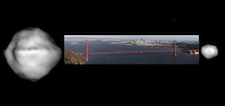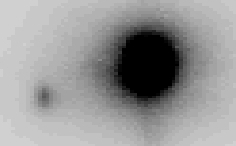Our research group's efforts fall primarily under two themes:
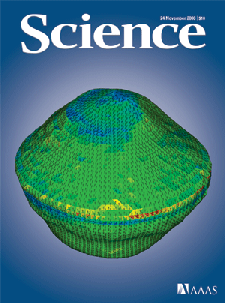
|
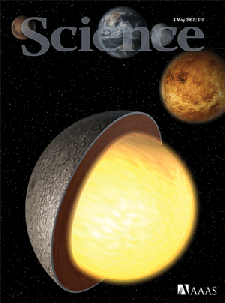
|
|
Physical and dynamical characterization of near-Earth objects, primarily with the very powerful tool of radar astronomy |
Description of planetary interior properties and processes from high-precision measurements of spin and orbital dynamics |
We rely on a combination of telescopic and spacecraft data at wavelengths ranging from optical to radio. The intersection of dynamics and geophysics is a proven area for fundamental advances in planetary science, and our goal is to provide important insights into the formation and evolution of habitable worlds.
Some research areas are listed below:
Radar Observations of Asteroids and Comets
|
The radar instruments at Arecibo and Goldstone provide exquisite measurements of the sizes, shapes, spins, and physical properties of Near-Earth Objects. We observe a variety of asteroids with radar, but we are particularly interested in binary and multiple systems (two or more rocks orbiting each other in space). Our observations can be used to measure the masses and densities of the components, and to study their dynamical interactions in great detail. These systems are extremely interesting as they exhibit processes such as avalanches, tides, librations, and YORP. Radar observations provide the most powerful way of characterizing binary and multiple systems from Earth. This figures shows a schematic representation of the size of the 2000 DP107 binary system, with the Golden Gate bridge for scale. Click on the image for more radar results. The radar work is performed in collaboration with a small number (<10) of scientists who routinely observe asteroids with radar. |
Planetary Interior Structure Revealed by Spin Dynamics
|
The spin state of a planet depends on external torques as well as on the distribution of mass and dissipation mechanisms within the interior. Detailed measurements of the spin dynamics can therefore provide a wealth of information about planetary interior structure and about a variety of important geophysical processes. We are interested in measuring small changes in the spin periods of Mercury, Venus and Europa, a satellite of Jupiter. Currently we primarily use an Earth-based radar technique that provides instantaneous spin state measurements with superb precision. We have established that Mercury has a molten core, which has fundamental implications for the composition, internal structure, thermal evolution, and magnetic field of the planet. We are trying to detect short-term, seasonal, and long-term changes in the spin rate of Venus, which would provide crucial data constraints on the climate and atmospheric dynamics. At Europa, we are interested in estimating the thickness of the ice shell, an important indicator of Europa's astrobiological potential. |
Dynamics of asteroids in Icarus-like orbits
Binary Asteroids in the Main Belt
|
We study binary asteroids located in the main belt of asteroids between Mars and Jupiter. We use powerful adaptive optics systems on large telescopes to search for asteroid companions and to characterize their orbital parameters (e.g. the Keck II telescope on Mauna Kea, Hawaii and the Very Large Telescope on Cerro Paranal, Chile). The figure to the left shows the discovery image of a satellite orbiting the 180-km diameter asteroid 22 Kalliope, the first companion detected around an M-class asteroid. The M asteroids are thought to be metal rich, but the density that can be derived from the system's orbital motion rules out a metallic composition. We have also discovered a satellite around 87 Sylvia, one of the 10 largest asteroids. At the time of discovery, Sylvia and its moon were 417 million kilometers away from Earth (about 1100 times the distance to the Moon), and the separation between the two was 1200 km (equivalent to the distance between Houston and El Paso).
|
Binary Trans-Neptunian Objects

|
Many minor planets orbit beyond the orbit of Neptune in a region aptly called the trans-Neptunian region. Those bodies are asteroids with a larger ice-rock fraction than those found closer to the sun. They are thought to be the precursor of short-period comets. Binary and multiple systems exist in that population as well, and Pluto-Charon is the most famous example. I am using the Hubble Space Telescope to characterize trans-Neptunian binaries in detail, and identified the triple system 1999 TC36. The trans-Neptunian binaries are thought to be primordial, and their abundance and properties constrain the environment in the earliest stages of solar system history, a very important boundary condition for theories of solar system formation. Observations of trans-Neptunian binary and multiple systems provide the first measurements of the density and mechanical properties of those distant ice-rock bodies. This work is performed in collaboration with Mike Brown, Chad Trujillo, and Reem Sari. |
Asteroid Imaging and Shape Modeling
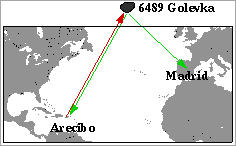
|
High resolution images and shape models of asteroids are important to understand the physical properties and interior structure of asteroids. I have been interested in using Earth-based radar instruments, such as those of Arecibo and Goldstone, to provide images of asteroids during their close approaches to Earth. I am pursuing various ideas to improve the imagery and three-dimensional characterization of such objects, including chirp-based and interferometry techniques. The first attempt to actually measure the topography of an asteroid was performed during the close approach of Asteroid 6489 Golevka in June 1999. The Arecibo radar was used to illuminate the asteroid, and a fast sampling system was set up to record the echoes at the NASA tracking station in Madrid, Spain, while collaborator Mike Nolan recorded the echoes at Arecibo. Combining signals from Arecibo and Madrid would in principle provide high resolution three-dimensional images of the asteroid. Although the asteroid was successfully detected at Madrid and Arecibo, there were a number of telescope problems which prevented the interferometric analysis. We are anxious to attempt this exciting experiment again on the next good opportunity. |
Instrumentation
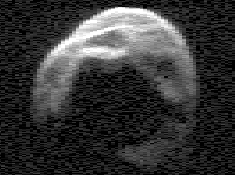
|
Some of my research projects require the ability to record signals at a very high speed. Designing and building a low-cost, portable fast sampler was therefore one of my priorities when I arrived at Arecibo. These systems have been installed at Arecibo and the Green Bank Telescope. Four units have been replicated at JPL for installation at the NASA tracking stations in Goldstone, California. The sampling system has been used to provide some of the highest resolution images of asteroids ever obtained. It has also been used to provide the first radar detection of a solar system object at NASA's tracking station in Madrid and the first radar image with NRAO's VLBA antenna in St-Croix. Other observations included OH masers and pulsars, many near-Earth asteroids, the rings of Saturn, and the Earth's ionosphere. In 2001 I also proposed, prototyped, and tested a chirp system for planetary radar. A similar system is now being installed at Goldstone. |
Lunar Research
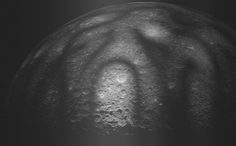
|
My Ph.D. work was primarily related to lunar studies. This work is described here. |
jlm@ess.ucla.edu

